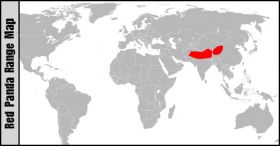Red Panda
Ailurus fulgens
Description
Red pandas, which resemble raccoons, are about 42 inches long, including a long, bushy tail. They weigh between seven and 14 pounds. Their red-and-white markings blend in with the red mosses and white lichens that grow on the trees in which they live. Their soft, dense fur covers their entire body, even the soles of their feet. Red pandas use their long, bushy tails to balance when they’re in trees. They also cover themselves with their tails in winter.
Distribution and Habitat
Red pandas live in the cool, temperate bamboo forests in China’s Sichuan and Yunnan Provinces, in the Himalayas, and in Myanmar. They share part of their range with giant pandas.
Diet
Red pandas primarily eat bamboo leaves, as well as berries, blossoms, bird eggs, and various plants’ small leaves. Their broad teeth and strong jaws allow them to chew bamboo’s tough leaves and stalks. They also have a small, bony projection on their wrists that helps them grip bamboo stalks. Giant pandas also have this thumb-like adaptation.
Reproduction
After a gestation of about 134 days, litters of one to four young are born. Young stay in the nest for about 90 days, remain close to their mother until the next mating season begins, and reach adult size at about 12 months. Adult red pandas lead solitary lives.
Conservation
Red pandas are endangered because of habitat loss. There are fewer than 2500 adult red pandas.
Red Panda facts
- Red Pandas are great tree climbers.
- Red Pandas eat the leaves of bamboo; Giant Pandas mostly eat the stems and shoots.
- Red pandas are mostly solitary animals.
- Red Pandas are active during the day.
Related Topics
Description
Red pandas, which resemble raccoons, are about 42 inches long, including a long, bushy tail. They weigh between seven and 14 pounds. Their red-and-white markings blend in with the red mosses and white lichens that grow on the trees in which they live. Their soft, dense fur covers their entire body, even the soles of their feet. Red pandas use their long, bushy tails to balance when they’re in trees. They also cover themselves with their tails in winter.
Distribution and Habitat
Red pandas live in the cool, temperate bamboo forests in China’s Sichuan and Yunnan Provinces, in the Himalayas, and in Myanmar. They share part of their range with giant pandas.
Diet
Red pandas primarily eat bamboo leaves, as well as berries, blossoms, bird eggs, and various plants’ small leaves. Their broad teeth and strong jaws allow them to chew bamboo’s tough leaves and stalks. They also have a small, bony projection on their wrists that helps them grip bamboo stalks. Giant pandas also have this thumb-like adaptation.
Reproduction
After a gestation of about 134 days, litters of one to four young are born. Young stay in the nest for about 90 days, remain close to their mother until the next mating season begins, and reach adult size at about 12 months. Adult red pandas lead solitary lives.
Conservation
Red pandas are endangered because of habitat loss. There are fewer than 2500 adult red pandas.
Red Panda facts
- Red Pandas are great tree climbers.
- Red Pandas eat the leaves of bamboo; Giant Pandas mostly eat the stems and shoots.
- Red pandas are mostly solitary animals.
- Red Pandas are active during the day.

































































































